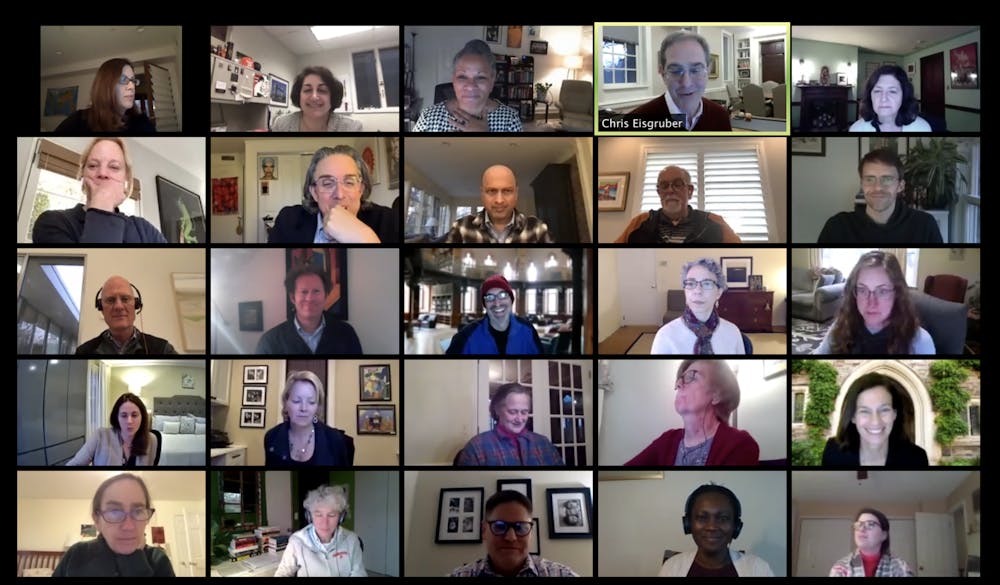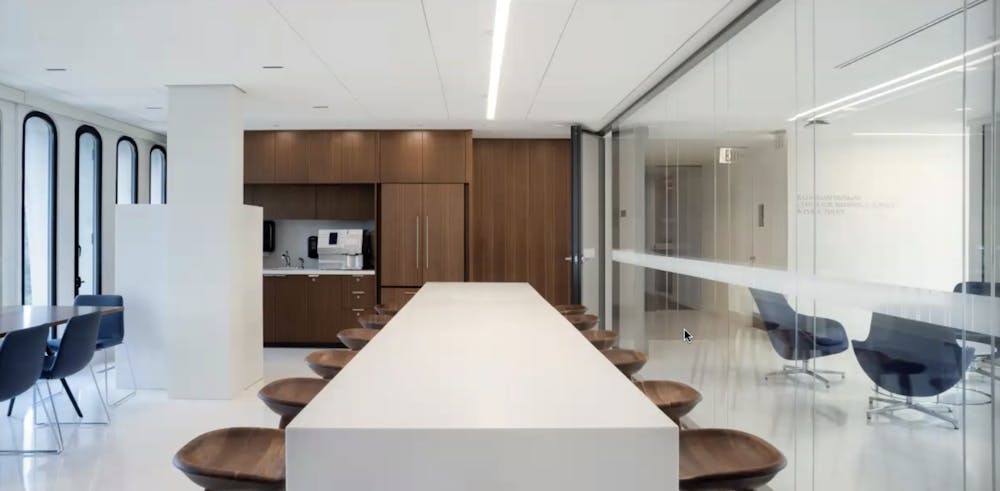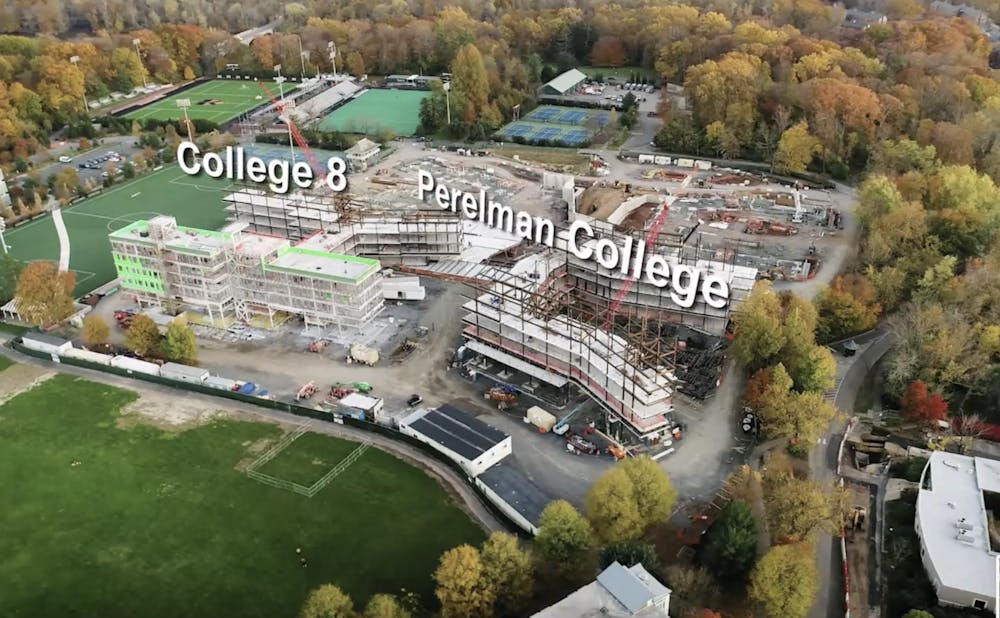“We are heading into a period of a lot of construction activity on campus,” University architect Ron McCoy said during a Council of the Princeton University Community (CPUC) meeting on Monday.
When students return in the spring, Perelman College and the yet-unnamed “College Eight” will both be under construction, with a series of new and old buildings to undergo construction between now and 2027. McCoy noted that this is will “be disruptive, certainly, and we’ll have as many conversations as it takes to manage this disruption.”
At the final CPUC meeting of the calendar year, administrators also touched on spring 2021 planning and COVID-19 testing, and attendees heard updates from Provost Deborah Prentice and Vice President for Campus Life Rochelle Calhoun on ongoing efforts to address systemic racism and the Ad Hoc Committee on Sexual Climate, Culture, and Conduct, respectively.
Pandemic planning
The event, held as a Zoom meeting rather the CPUC’s previously-used webinar format in order to enable discussion, began with an update on spring planning. University President Christopher Eisgruber ’83 and Executive Director for Health and Safety Robin Izzo reiterated many key points regarding on-campus testing and quarantine policy.
Izzo outlined the move-in and quarantine policy announced last week, which will shorten the arrival quarantine period for on-campus students to seven days if they report no symptoms throughout that period and receive negative results taken both upon arrival and on the fifth or sixth day of their quarantine — in line with revised guidance from the Centers for Disease Control and Prevention (CDC) and the New Jersey Department of Health.
Despite rising case counts in the area, Izzo added that the University has seen “very little transmission” relating to on-campus activities in 16 weeks of on-campus testing. The University has conducted over 60,000 tests during that time via its asymptomatic testing protocol.
Izzo added that the on-campus testing lab processed “75 percent” of tests conducted last week internally, with a “quick turnaround time that they’ve been able to maintain.” The remaining 25 precent of tests are processed through Accurate Diagnostics, a company that the University has worked with since the start of its asymptomatic screening program. However, Izzo stated that “the majority of tests will be processed on campus” this spring.

“We are ramping up capacity right now in the laboratory, so the percentage will continue to increase,” Eisgruber added.
Multiple times, Eisgruber emphasized the importance of “taking responsibility,” “supporting one another,” and establishing “community culture of care on campus.” He said that while widespread testing is key to enabling students to return, “testing is not a substitute for [campus] culture.”

Departmental committees, continuing education, and campus culture

In her brief update on efforts to address systemic racism, Prentice pointed mostly to work being undertaken in individual academic units — meaning specific departments, programs, and institutes.
“I’ve spoken in the past about the initiatives that we have been taking charge of centrally, but actually there’s a lot of excellent work being done in the academic units themselves,” she said.
In terms of infrastructure, Prentice’s presentation stated that 23 academic units have created Diversity, Equity, Climate, and Inclusion Committees, most including faculty, student, and staff representatives. Five have appointed a specific “Diversity & Inclusion Officer” in order to facilitate concerted action, she added.
Within a number of departments, Prentice added that there are ongoing collaborative efforts involving students and faculty to diversify curricula. Many departments are also attempting to diversify the academic pipeline through faculty and post-doctoral student hiring, graduate student admissions, and recruiting “diverse undergraduates,“ she said.
Prentice also said many academic units are working on improving the use of both demographic and survey data to support diversity and mentioned a “symposium” that may be used to “showcase this departmental activity.”
“We hope to do that after the start of the new year, sometime in January or February,” she added.
Asked what campus resources would be available, particularly for small academic units with fewer resources, Prentice said the University is trying to build out existing central programs like University’s Target of Opportunity program, which provides departments resources for faculty diversification.
Asked for an update on Eisgruber’s previous statement that the University is “exploring the possibility of a new credit- or degree-granting program that would extend Princeton’s teaching to a new range of students disproportionately affected by systemic racism,” Prentice said the process is in its early stages.
Specifically, the University has put together a committee that includes leadership of existing outreach programs, including heads of the Prison Teaching Initiative, Princeton Online Tutoring Network, and the Continuing Education Program.
“We’re going to try to take those as a starting point,” Prentice said. “We’re going to try and take those programs to the next level — to lift them up, to give them what they need to take their next step — and we think we’ll learn a lot through that process about what we need to do to amount something new.”
In regards to long term efforts, Prentice said the University is hoping to offer credit for online courses and is attempting to build a capacity to do so.
“We’re not going to have a major new initiative to announce before the end of this academic year,” she added. “I hope what we will have is a number of next steps for our existing programs and a good idea of where we’re heading for that new initiative.”
Calhoun also updated the CPUC on the work of the Ad Hoc Committee on Sexual Climate, Culture and Conduct, created in June 2019.
The group met with student leaders to discuss campus culture in October, during which undergraduates expressed a sense of “a gap in the programming and learning [involving sexual misconduct and campus culture] that occurs in the sophomore year,” a topic Calhoun says the committee “will be following up on.” She said students also spoke about “power dynamics within student organizations that can have a negative impact on culture and climate issues on campus.”
In November, the committee met with McCoy and other administrators within facilities and housing to discuss how space design can influence student behavior and campus culture.
“We had a great conversation that really looked at mostly residential spaces,” she said. “So what’s the furniture in residential spaces, what happens when you get into a small room where there’s one chair and a bed, and how do we change that dynamic by changing what’s in the space.”
In response to a question regarding how University sexual misconduct policy could be affected by president-elect Joe Biden’s administration, Vice Provost for Institutional Equity and Diversity Michelle Minter said that the University “certainly expect[s] changes will come” regarding Title IX but not “for some time.”
“The Biden Administration will have to file its own proposed regulations, there will be a comment period, they will eventually have to respond to all those comments, and then the regulations will go into effect,” Minter said. “So even if they move very quickly, realistically there’s probably a year or so lag before a new revised set of regulations will go into effect.”
Campus construction
McCoy updated the CPUC on campus architecture, both looking at recently-completed projects and expectations for the next six to seven years. Notably, Perelman College and “College Eight” are now under construction near Poe Field with construction “quickly advancing from north to south.” Unlike many of the University’s traditionally-opaque buildings, McCoy said the architects are attempting to make the buildings themselves “as transparent as possible” to create an open and welcoming environment.
The University is also “just beginning” the concept designing process for Hobson College, named for Mellody Hobson ’91, which will “take over the footprint of existing First College, just off of Elm Drive.”
McCoy also discussed recent renovations of the McCosh 50 lecture hall and Robertson Hall, home of the School of Public and International Affairs (SPIA).

Robertson Hall’s renovation aimed to create a more transparent and open space to support community interaction. McCosh 50 was renovated primarily for the purpose of “enhancing teaching” according to McCoy, with new acoustics, video systems, lighting systems, and slightly wider and deeper chairs with cushioning. McCoy said the space is ready for occupancy, adding that his hope is “you walk into the space and it looks slightly more glorious, but you don’t know what happened.”
McCoy also displayed plans for engineering and environmental studies buildings east of the Center for Jewish Life, which were presented before the Princeton Planning Board in October. Additionally, he pointed to plans for a new geo-exchange facility — the Thermally Integrated Geo-Exchange Resource (TIGER) — as an important part of the University’s goal of achieving carbon neutrality by 2046.

Plans for new engineering and environmental science facilities, presented at the meeting by University Architect Ron McCoy.
McCoy also outlined other components of the University’s Campus Plan, including plans for a new health services building at the site of Eno Hall, an addition to Dillon Gymnasium, a Lake Campus south of Lake Carnegie with graduate housing and a racket sports center, the rebuild of Guyot Hall to house the computer science department, and an anticipated new art museum.
“A lot of construction [will take place] between now and the end of 2026, early 2027,” McCoy said. “And we’ll be working closely with our campus partners to manage the disruption and look for support to help advance these important initiatives.”
The next CPUC meeting is scheduled for Feb. 8, 2021.








